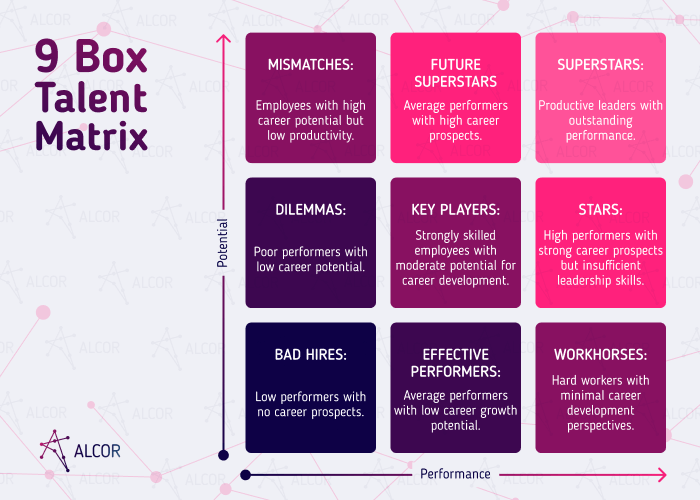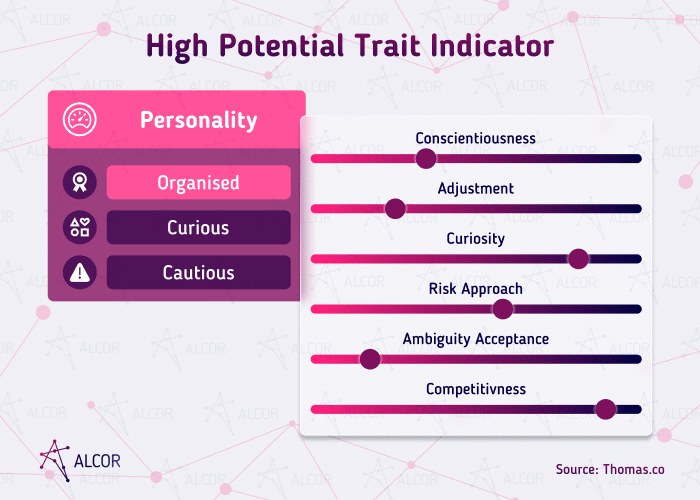In a team of skilled specialists, there’re always some talents who truly shine and stand out from the rest. On average, these high-potential employees make up approximately 5% of a company’s total workforce. Yet despite their valuable presence, by no means do all tech employers know why and how to identify high-potential employees in their company.
Keep reading this article to discover the HiPo employee meaning, the key qualities of these talents, the benefits of fostering them for your tech business, efficient tips to spot HiPos, along with possible challenges and solutions.
What is a High-Potential Employee?
A high-potential employee (or HiPo) is a person who has the necessary skills and motivation to excel in their current role and demonstrates the potential for future leadership or management positions within a company.
Characteristics of High-Potential (HiPo) Employees
As a rule, such employees exhibit a combination of unique characteristics that set them apart from their peers. Although each individual may possess their own distinct traits, there are common qualities often observed in high-potential talent. Thus, the Harvard Business Review outlines three key markers of high potential:
- Social skills – these employees excel in self-management and effectively managing others. They thrive under pressure, handle adversity, and are skilled at building and maintaining positive relationships with colleagues.
- Ability – they demonstrate a high IQ, adaptability in acquiring new knowledge, and applying it effectively. Additionally, they exhibit visionary thinking, creativity, and imagination.
- Drive – HiPos are driven individuals with a strong motivation and ambition to excel in their current roles and advance their careers. They are willing to overcome personal challenges to achieve their professional goals.
High-Potential Vs High-Performance: What’s the Difference?
Although the definition of a HiPo employee is known per se, tech entrepreneurs often mistake them for high-performance teammates, or vice versa. Approximately 90% of high-performance employees face challenges when they are promoted to positions with greater responsibilities and leadership requirements. That’s why it’s crucial to distinguish them as it plays a significant role in succession planning, talent development & retention, and resource allocation.
A high-performance employee consistently delivers excellent results, produces high-quality work, and exceeds the company’s expectations. Usually, these individuals thrive when working independently and possess a remarkable ability to stay laser-focused on their tasks. High-performance employees primarily surpass goals within their specific roles but lack the necessary soft skills to become strong leaders.
On the other hand, a HiPo employee has great prospects in management roles and possesses exceptional soft skills to lead the team toward achieving the company’s goals. Thus, HIPOs have a unique blend of interpersonal skills, emotional intelligence, and the ability to inspire and motivate others. A high-potential leader also demonstrates a remarkable capacity for personal growth and continuous learning, striving to expand their skill set.
The widely recognized nine-box grid is a valuable tool for distinguising and assessing a company’s talent pool. It evaluates performance (horizontal axis) and potential (vertical axis) to identify high-potential employees who deliver results and are worth investing in, as well as low-potential employees who may hinder growth. Ideally, these employees should be Superstars excelling in both performance and potential, driving the company towards success.

Benefits of Developing High-Potential Employees for IT Business
Now, you’re probably wondering – what are the advantages of developing high-potential employees within your IT company? Let’s have a look at the following strong points that can benefit your business:
-
Increased productivity
HiPo talent’s commitment to excellence results not only in first-rate work but also inspires other colleagues to push their boundaries and reach for greater heights. In such a way, persistent striving for remarkable achievements becomes contagious, fostering a productive working environment and raising the bar of overall performance.
-
High employee engagement
In a culture of high employee engagement, individuals are fully involved and passionate about their work. They take ownership of their responsibilities, actively seek ways to improve their performance, and willingly collaborate with others to achieve shared objectives.
-
Strong leadership pipeline
In the long run, investing in high-potential employee development results in a robust leadership pipeline that ensures continuity and stability within the organization. As current leaders progress in their careers or transition to new roles, the presence of well-prepared successors ensures a seamless transition that minimizes disruptions and sustains the momentum necessary to drive the company’s strategic objectives forward.
Fascinated by the tangible benefits of developing these A-players at their companies, tech entrepreneurs promptly launch high-potential employee programs. However, HBR states that more than 40% of employees may not belong in these programs, and hence, they do not bring desirable results. That’s why it’s essential to pay special attention to the identification stage.
4 Tips How To Identify High-Potential Employees
1. Seek life-long learners
High-potential employees are driven to explore new knowledge, eagerly learn new skills, and take on bold challenges. They have an unstoppable determination to grow professionally, leaving no opportunity untapped. Look for individuals who show curiosity, tenacity, and a strong thirst for knowledge. Usually, they proactively engage in learning activities and hunt for valuable resources and information to deepen their knowledge.
2. Track performance and results
Another usefult tip that can help you spot HiPos at your company is keeping an eye on their performance and productivity. Such teammates regurarly show good results, have great expertise in their field, and are always ready to give 110% to achieve the company’s goals. Gartner research states that high-potential employees contribute 91% more value to the organization compared to their non-HiPos. Moreover, they demonstrate an impressive 21% increase in effort compared to their peers. To measure their performance effectively, define and set clear KPIs and SMART goals, implement monthly or quarterly performance reviews and assessments, conduct regular one-to-ones, etc. These strategies contribute to a more coherent and systematic approach to identifying high-potential employees within your company.
3. Assess leadership potential
The distinguishing characteristic that sets high-potential employees apart is their exceptional leadership skills, which greatly help in their identification. Great leaders are effective communicators and good listeners who demonstrate a high level of empathy and emotional intelligence. To identify potential leaders, closely observe their collaborative abilities, problem-solving skills, responses to challenges, decision-making aptitude, and ability to inspire others.
4. Collect 360-degree feedback
High-potential employees are servant-leaders. Although it may seem to you that these individuals demonstrate great leadership and management skills, it’s crucial to seek feedback from the individuals who closely work with them. To do this, select the most efficient approaches and techniques for collecting feedback that would work for your team. For example, 360-degree feedback is a popular practice among tech companies. It’s an evaluation system designed to gather confidential and anonymous feedback about employees from individuals who interact with them regularly. This inclusive process involves soliciting input from various management levels, including the employee’s manager, supervisor, subordinates, and peer colleagues.
Challenges of Identifying a High-Potential Employees
-
Subjectivity
The human element plays a significant role in the identification process, but it comes with its challenges. Subjectivity has the potential to sway the evaluations of managers, as unconscious biases or personal preferences may inadvertently influence their decisions. It can create an unfair environment where deserving candidates are overlooked, while others may be favored and promoted based on personal connections rather than merit.
Solution: To foster objectivity, you can design and implement clear criteria and metrics to evaluate potential. For instance, you can conduct psychometric assessments and other tests to check employees’ competence and skills. A High Potential Trait Indicator (HPTI) stands as a popular assessment tool utilized to delve into a candidate’s personality traits and to gain valuable insights into a candidate’s potential for success and growth within the organization. HPTI measures the following traits: adjustment, conscientiousness, risk approach, curiosity, competitiveness, and ambiguity acceptance. It’s a self-report questionnaire that individuals complete by indicating their agreement level on a 1-7 Likert scale and taking not more than ca. 8 minutes.

-
Lack of development opportunities
It’s rather challenging to spot hidden gems in your team if there’s no space and possibilities for them to come off. Limiting employees’ proactivity, desire to grow as professionals, or taking on more responsibility won’t only hinder development of HiPos at your company, but also leads to burnout and low productivity.
Solution: To uncover hidden potential, engage autonomy and avoid micromanagement at the workplace. Thus, you will provide room for employees to showcase their talents and encourage them to take on new responsibilities. You can also launch educational and mentorship programs, offer learning programs, and other initiatives that will help your employees grow as both specialists and leaders.
-
Limited pool of A-players
Finding high-potential candidates can be quite a challenge. These individuals are often highly sought after or have unique skills that set them apart, resulting in a limited number of such talent available. This scarcity makes it even more difficult to attract and identify those exceptional individuals who possess remarkable potential.
Solution: Efficient IT recruitment can help you find and hire more tech Superstars for your team. Professional headhunters have the expertise and networks to tap into a wider talent pool, uncovering those rare talents with exceptional potential. In addition to networking, recruiters are armed with a range of paid resources and specialized recruiting platforms, providing them with access to a vast pool of highly skilled candidates. These valuable tools expand their reach and enable connecting with talented candidates who might have otherwise gone unnoticed.
Consider Alcor as Your Reliable Partner in IT Recruitment
Every company aims at hiring talented A-players for their teams who drive success, inspire innovation, and elevate the overall performance of the organization. That’s where Alcor can help you.
Reaching out to a realiable IT recruitment services provider was Gotransverse’s decision. The company wanted to hire 6 skilled software engineers within short timeframes. To help Gotransverse execute its ambitious plan, we sourced perfect candidates who would be a perfect fit for their opened positions. For this, we prepared eye-catching job descriptions, while 95% of the CVs presented to the client were successful. As a result, our team managed to hire a product manager with exceptional leadership skills and 5 software developers with the required tech stack. In addition, we helped Gotrasverse with employer-of-record services, handled finance operations, and helped with IT procurement.
Want to learn more about other success stories examples? Have a look at the case study of BigCommerce or the case study of People.ai!
At Alcor, we focus on recruiting Senior/Lead software developers from Poland, Romania, Bulgaria, and other Eastern European countries. We provide full-cycle recruitment services as well as help with payroll, equipment procurement, and legal compliance with both American and European law. We vow to hire 5 IT talents within 1 month and 20+ developers within 3 months! If we don’t meet the deadlines, we’ll hire the rest at no charge to you!
FAQ
❓ What is the HiPo employee meaning?
A high-potential talent (or HiPo) is an individual who has the necessary skills and motivation to excel in their current role and demonstrate the potential for future leadership roles.
How to identify high potential employees in the company?
Some possible approaches include seeking life-long learners and assesing leadership potential. Read this article to find out more ways of spotting HiPo talents in your company!
What are the advantages of developing HiPos for your IT business?
The main benefits are increased company productivity, high employee engagement, and a robust leadership pipeline.
